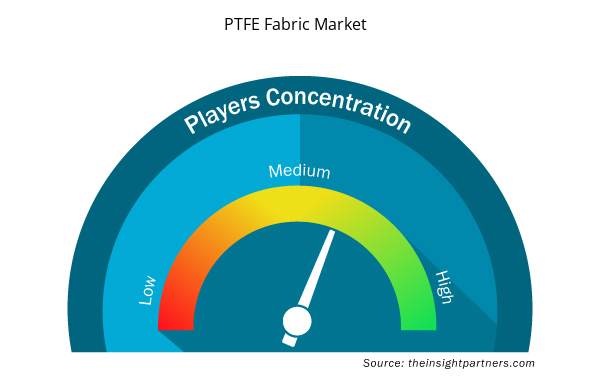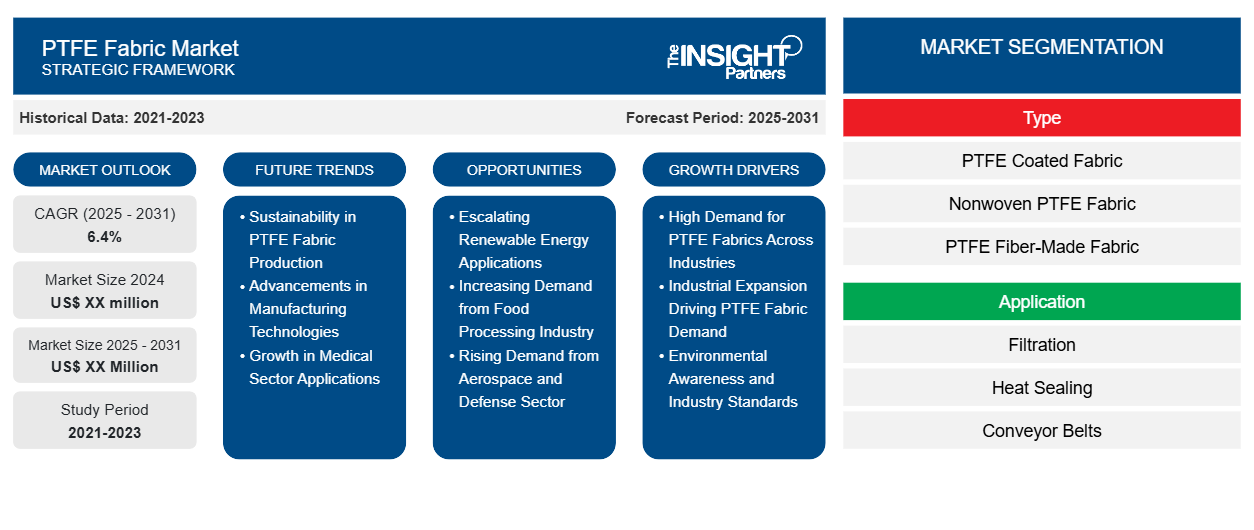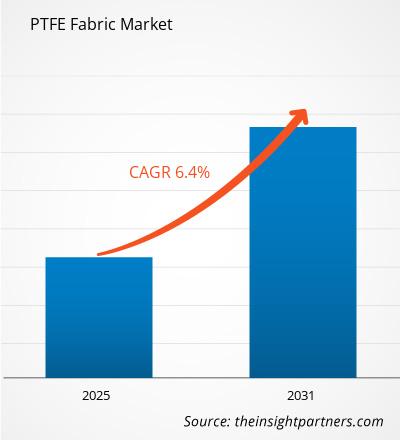Der Markt für PTFE -Gewebe wird voraussichtlich von 2024 bis 2031 eine durchschnittliche jährliche Wachstumsrate (CAGR) von 6,4 % verzeichnen , wobei die Marktgröße von XX Millionen US-Dollar im Jahr 2024 auf XX Millionen US-Dollar im Jahr 2031 anwachsen wird.
Der Bericht ist nach Typ segmentiert ( PTFE -beschichtetes Gewebe, PTFE- Vliesgewebe , PTFE -Fasergewebe und andere). Der Bericht ist weiter nach Anwendung segmentiert (Filtration, Heißsiegelung, Förderbänder und andere). Der Berichtsumfang umfasst fünf Regionen: Nordamerika, Europa, Asien-Pazifik, Naher Osten und Afrika sowie Süd- und Mittelamerika und Schlüsselländer in jeder Region. Die globale Analyse ist weiter auf regionaler Ebene und in den wichtigsten Ländern aufgeschlüsselt. Der Bericht bietet den Wert in USD für die oben genannte Analyse und Segmente.
Zweck des Berichts
Der Bericht PTFE Fabric Market von The Insight Partners zielt darauf ab, die aktuelle Landschaft und das zukünftige Wachstum sowie die wichtigsten treibenden Faktoren, Herausforderungen und Chancen zu beschreiben. Dies wird verschiedenen Geschäftspartnern Einblicke geben, wie zum Beispiel:
- Technologieanbieter/-hersteller: Um die sich entwickelnde Marktdynamik zu verstehen und die potenziellen Wachstumschancen zu kennen, damit sie fundierte strategische Entscheidungen treffen können.
- Investoren: Durchführung einer umfassenden Trendanalyse hinsichtlich der Marktwachstumsrate, der finanziellen Marktprognosen und der Chancen entlang der Wertschöpfungskette.
- Regulierungsbehörden: Zur Regulierung von Richtlinien und Überwachungsaktivitäten auf dem Markt mit dem Ziel, Missbrauch zu minimieren, das Vertrauen der Anleger zu bewahren und die Integrität und Stabilität des Marktes aufrechtzuerhalten.
PTFE -Gewebe Marktsegmentierung
Typ
- PTFE- beschichtetes Gewebe
- PTFE - Vliesstoff
- PTFE -Fasergewebe
Anwendung
- Filtration
- Heißsiegeln
- Förderbänder
Passen Sie diesen Bericht Ihren Anforderungen an
Sie erhalten kostenlos individuelle Anpassungen an jedem Bericht, einschließlich Teilen dieses Berichts oder einer Analyse auf Länderebene, eines Excel-Datenpakets sowie tolle Angebote und Rabatte für Start-ups und Universitäten.
- Holen Sie sich die wichtigsten Markttrends aus diesem Bericht.Dieses KOSTENLOSE Beispiel umfasst eine Datenanalyse von Markttrends bis hin zu Schätzungen und Prognosen.
Wachstumstreiber auf dem PTFE -Gewebemarkt
- Hohe Nachfrage nach PTFE -Geweben in allen Branchen: PTFE -Gewebe sind aufgrund ihrer hervorragenden Eigenschaften wie extreme Temperaturbeständigkeit, Chemikalienbeständigkeit, Feuchtigkeitsbeständigkeit und elektrische Leitfähigkeit sehr wertvoll. Dies qualifiziert den Einsatz von PTFE in der Luft- und Raumfahrt, der Automobilindustrie, der Pharmaindustrie und der Lebensmittelverarbeitung, da dort hohe Leistungsfähigkeit gefordert ist. Die Nachfrage nach PTFE -Geweben steigt rasant, da die Industrie sich verstärkt auf die Verwendung moderner Materialien konzentriert, die langlebiger, sicherer und effizienter sind. PTFE ist für den Einsatz in der Luft- und Raumfahrt sowie im Automobilbereich wichtiger geworden, da PTFE eine erhebliche Beständigkeit gegen korrosive Umgebungsbedingungen sowie extrem hohe Temperaturen bietet.
- Industrielle Expansion treibt Nachfrage nach PTFE-Gewebe: Die industrielle Expansion, vor allem in Schwellenländern, ist einer der Haupttreiber für die Nachfrage nach PTFE-Geweben. In mehreren Öl-, Gas- und Energie- sowie Chemieindustrien werden qualitativ hochwertigere Filterdichtungsmaterialien und Schutzbeschichtungen benötigt, um den PTFE-Einsatz in der Industrie zu steigern. Mit der Entwicklung produktionsbasierter Industrien ist zu erwarten, dass die größte Nachfrage nach PTFE-Geweben in Isoliermaterial für Dichtungen von Filtersystemen in den asiatisch-pazifischen Regionen besteht.
- Umweltbewusstsein und Industriestandards: Das weltweit wachsende Bewusstsein für Umweltprobleme und die hohen Standards in der Lebensmittelverarbeitung sowie in der Pharma- und Chemieindustrie erfordern eine steigende Nachfrage nach PTFE-Geweben. PTFE-Gewebe werden aus Sicherheitsgründen und zur Einhaltung von Umwelt- und Gesundheitsstandards in den meisten emissionsreduzierenden Filtersystemen und in persönlicher Schutzausrüstung verwendet. Dies verhindert Verunreinigungen und macht Arbeitsplätze sicherer, weshalb ihre Akzeptanz in allen Branchen zunimmt.
PTFE-Gewebemarkt: Zukünftige Trends
- Nachhaltigkeit in der PTFE-Gewebeproduktion: Einer der Trends ist die zunehmende Entwicklung und Einführung umweltfreundlicher oder nachhaltig produzierter PTFE-Gewebe. Unternehmen arbeiten an einer nachhaltigeren Produktion, indem sie die Verwendung schädlicher, giftiger und nicht biologisch abbaubarer Materialien bei der Herstellung von PTFE-Geweben reduzieren. Es werden Innovationen im Hinblick auf die Reduzierung des ökologischen Fußabdrucks ihrer Produkte durchgeführt, und Unternehmen entwickeln innovative umweltfreundliche Alternativen, um den Anforderungen der Verbraucher nach nachhaltigen Lösungen gerecht zu werden.
- Fortschritte in der Fertigungstechnologie: Der PTFE-Gewebemarkt erlebt technologische Fortschritte bei der Herstellung dieser Gewebe, insbesondere in Bezug auf Fertigungstechniken und Anwendungen. Neue Verfahren wie die ePTFE-Technologie werden zunehmend in die Produktlinien eingeführt, wodurch das Gewebe haltbarer, flexibler und durchlässiger wird. Dadurch kann PTFE-Gewebe ein viel breiteres Anwendungsspektrum in den Bereichen Medizin, Filtration und Hochleistungsindustrie abdecken.
- Wachstum bei Anwendungen im medizinischen Sektor: Der medizinische Sektor wird aufgrund seiner guten Biokompatibilität und Chemikalienbeständigkeit zu einem wachsenden Markt für PTFE-basierte Stoffe. Zu den Anwendungen in medizinischen Geräten gehören Implantate, chirurgisches Klebeband und Wundauflagen. Innovationen im Gesundheitswesen, die Zunahme chronischer Krankheiten und die Überalterung der Bevölkerung führen zu einer steigenden Nachfrage nach PTFE in medizinischen Anwendungen, da heute umfangreiche Forschungen zur Erforschung biotechnologischer und medizinischer Anwendungen durchgeführt werden.
Marktchancen für PTFE-Gewebe
- Zunehmende Anwendungsmöglichkeiten für erneuerbare Energien: Erneuerbare Energien sind ein vielversprechender Bereich für den PTFE-Gewebemarkt. PTFE-Gewebe werden in mehreren Nischenanwendungen wie Solarmodulen, Wartung von Windturbinen und Filterung von Stromerzeugungssystemen eingesetzt. Aufgrund des Wachstums dieser Branche, das durch den weltweiten Bedarf an sauberen Energielösungen angetrieben wird, wird erwartet, dass ihre Nachfrage in Nischenanwendungen steigen wird.
- Steigende Nachfrage aus der Lebensmittelindustrie: PTFE-Gewebe wird in der Lebensmittelindustrie häufig verwendet, vor allem weil es kein Anhaften zulässt, chemikalienbeständig und langlebig ist. Da die Nachfrage nach verarbeiteten Lebensmitteln zusammen mit höheren Hygiene- und Sicherheitsstandards wächst, wird der Lebensmittelverarbeitungssektor zu einem potenziellen Wachstumsbereich für Hersteller von PTFE-Gewebe. Das Material wird häufig in Anwendungen wie Förderbändern, Backblechen und Kochgeräten verwendet. Mit wachsenden Lebensmittelproduktions- und Verpackungstechnologien wird die Nachfrage steigen.
- Steigende Nachfrage aus der Luft- und Raumfahrtbranche und dem Verteidigungssektor: Die Luft- und Raumfahrtbranche sowie die Verteidigung sind eine der wichtigsten Marktchancen für PTFE-Gewebe. Mit neuen Anwendungen für leichte, langlebige und hitzebeständige Materialien in Flugzeugen, Raumfahrzeugen und beim Militär ergeben sich neue Möglichkeiten. PTFE-Gewebe können zur Herstellung von Dichtungen, Versiegelungen, Isoliermaterialien und Schutzabdeckungen verwendet werden. Die Verteidigungsausgaben steigen weltweit, ebenso wie der Flugverkehr. In diesen Sektoren wird die Nachfrage nach PTFE-Gewebe wahrscheinlich steigen, und dies bietet enorme Marktchancen.
Regionale Einblicke in den PTFE-Gewebemarkt
Die regionalen Trends und Faktoren, die den PTFE-Gewebemarkt im Prognosezeitraum beeinflussen, wurden von den Analysten von Insight Partners ausführlich erläutert. In diesem Abschnitt werden auch PTFE-Gewebemarktsegmente und -geografie in Nordamerika, Europa, im asiatisch-pazifischen Raum, im Nahen Osten und Afrika sowie in Süd- und Mittelamerika erörtert.

- Erhalten Sie regionale Daten zum PTFE-Gewebemarkt
Umfang des Marktberichts über PTFE-Gewebe
| Berichtsattribut | Details |
|---|---|
| Marktgröße im Jahr 2024 | XX Millionen US-Dollar |
| Marktgröße bis 2031 | XX Millionen US-Dollar |
| Globale CAGR (2025 - 2031) | 6,4 % |
| Historische Daten | 2021-2023 |
| Prognosezeitraum | 2025–2031 |
| Abgedeckte Segmente | Nach Typ
|
| Abgedeckte Regionen und Länder | Nordamerika
|
| Marktführer und wichtige Unternehmensprofile |
|
Dichte der Marktteilnehmer für PTFE-Gewebe: Auswirkungen auf die Geschäftsdynamik verstehen
Der Markt für PTFE-Gewebe wächst rasant, angetrieben durch die steigende Nachfrage der Endverbraucher aufgrund von Faktoren wie sich entwickelnden Verbraucherpräferenzen, technologischen Fortschritten und einem größeren Bewusstsein für die Vorteile des Produkts. Mit steigender Nachfrage erweitern Unternehmen ihr Angebot, entwickeln Innovationen, um die Bedürfnisse der Verbraucher zu erfüllen, und nutzen neue Trends, was das Marktwachstum weiter ankurbelt.
Die Marktteilnehmerdichte bezieht sich auf die Verteilung der Firmen oder Unternehmen, die in einem bestimmten Markt oder einer bestimmten Branche tätig sind. Sie gibt an, wie viele Wettbewerber (Marktteilnehmer) in einem bestimmten Marktraum im Verhältnis zu seiner Größe oder seinem gesamten Marktwert präsent sind.
Die wichtigsten auf dem PTFE-Gewebemarkt tätigen Unternehmen sind:
- Aetna Kunststoffe
- Faserflon
- Fothergill-Gruppe
- Saint-Gobain Performance Plastics
- Sefar
Haftungsausschluss : Die oben aufgeführten Unternehmen sind nicht in einer bestimmten Reihenfolge aufgeführt.

- Überblick über die wichtigsten Akteure auf dem PTFE-Gewebemarkt
Wichtige Verkaufsargumente
- Umfassende Abdeckung: Der Bericht deckt die Analyse von Produkten, Dienstleistungen, Typen und Endbenutzern des PTFE-Gewebemarktes umfassend ab und bietet einen ganzheitlichen Überblick.
- Expertenanalyse: Der Bericht basiert auf dem umfassenden Verständnis von Branchenexperten und Analysten.
- Aktuelle Informationen: Der Bericht stellt durch die Abdeckung aktueller Informationen und Datentrends Geschäftsrelevanz sicher.
- Anpassungsoptionen: Dieser Bericht kann angepasst werden, um spezifische Kundenanforderungen zu erfüllen und die Geschäftsstrategien optimal anzupassen.
Der Forschungsbericht zum PTFE-Gewebemarkt kann daher dabei helfen, die Branchensituation und Wachstumsaussichten zu entschlüsseln und zu verstehen. Obwohl es einige berechtigte Bedenken geben kann, überwiegen die allgemeinen Vorteile dieses Berichts tendenziell die Nachteile.
- Historische Analyse (2 Jahre), Basisjahr, Prognose (7 Jahre) mit CAGR
- PEST- und SWOT-Analyse
- Marktgröße Wert/Volumen – Global, Regional, Land
- Branche und Wettbewerbsumfeld
- Excel-Datensatz



Report Coverage
Revenue forecast, Company Analysis, Industry landscape, Growth factors, and Trends

Segment Covered
This text is related
to segments covered.

Regional Scope
North America, Europe, Asia Pacific, Middle East & Africa, South & Central America

Country Scope
This text is related
to country scope.
Häufig gestellte Fragen
Technological advancements in PTFE fabric production is expected to be the key market trend.
The report can be delivered in PDF/Word format, we can also share excel data sheet based on request.
On the basis of geography, the PTFE fabric market is classified into North America, Europe, Asia Pacific, Middle East and Africa, and South and Central America
#Aetna Plastics Corp, WL Gore & Associates Inc, Siftex Equipment Co Inc, CENO Tec GmbH, W F Lake Corp, Compagnie de Saint Gobain SA, Sefar India Pvt Ltd, Textiles Coated International, and Fiberflon
The major factors driving the PTFE fabric market are:
1. Growing Demand for High-Performance Materials.
2. Expansion of the Industrial Sector.
The PTFE Fabric Market is estimated to witness a CAGR of 6.4% from 2023 to 2031
Trends and growth analysis reports related to Chemicals and Materials : READ MORE..
1. Aetna Plastics
2. Fiberflon
3. Fothergill Group
4. Saint-Gobain Performance Plastics
5. Sefar
6. Siftex
7. Taconic
8. The Chemours Company
9. W. L. Gore & Associates, Inc.
10. W. F. Lake Corp.
The Insight Partners performs research in 4 major stages: Data Collection & Secondary Research, Primary Research, Data Analysis and Data Triangulation & Final Review.
- Data Collection and Secondary Research:
As a market research and consulting firm operating from a decade, we have published and advised several client across the globe. First step for any study will start with an assessment of currently available data and insights from existing reports. Further, historical and current market information is collected from Investor Presentations, Annual Reports, SEC Filings, etc., and other information related to company’s performance and market positioning are gathered from Paid Databases (Factiva, Hoovers, and Reuters) and various other publications available in public domain.
Several associations trade associates, technical forums, institutes, societies and organization are accessed to gain technical as well as market related insights through their publications such as research papers, blogs and press releases related to the studies are referred to get cues about the market. Further, white papers, journals, magazines, and other news articles published in last 3 years are scrutinized and analyzed to understand the current market trends.
- Primary Research:
The primarily interview analysis comprise of data obtained from industry participants interview and answers to survey questions gathered by in-house primary team.
For primary research, interviews are conducted with industry experts/CEOs/Marketing Managers/VPs/Subject Matter Experts from both demand and supply side to get a 360-degree view of the market. The primary team conducts several interviews based on the complexity of the markets to understand the various market trends and dynamics which makes research more credible and precise.
A typical research interview fulfils the following functions:
- Provides first-hand information on the market size, market trends, growth trends, competitive landscape, and outlook
- Validates and strengthens in-house secondary research findings
- Develops the analysis team’s expertise and market understanding
Primary research involves email interactions and telephone interviews for each market, category, segment, and sub-segment across geographies. The participants who typically take part in such a process include, but are not limited to:
- Industry participants: VPs, business development managers, market intelligence managers and national sales managers
- Outside experts: Valuation experts, research analysts and key opinion leaders specializing in the electronics and semiconductor industry.
Below is the breakup of our primary respondents by company, designation, and region:

Once we receive the confirmation from primary research sources or primary respondents, we finalize the base year market estimation and forecast the data as per the macroeconomic and microeconomic factors assessed during data collection.
- Data Analysis:
Once data is validated through both secondary as well as primary respondents, we finalize the market estimations by hypothesis formulation and factor analysis at regional and country level.
- Macro-Economic Factor Analysis:
We analyse macroeconomic indicators such the gross domestic product (GDP), increase in the demand for goods and services across industries, technological advancement, regional economic growth, governmental policies, the influence of COVID-19, PEST analysis, and other aspects. This analysis aids in setting benchmarks for various nations/regions and approximating market splits. Additionally, the general trend of the aforementioned components aid in determining the market's development possibilities.
- Country Level Data:
Various factors that are especially aligned to the country are taken into account to determine the market size for a certain area and country, including the presence of vendors, such as headquarters and offices, the country's GDP, demand patterns, and industry growth. To comprehend the market dynamics for the nation, a number of growth variables, inhibitors, application areas, and current market trends are researched. The aforementioned elements aid in determining the country's overall market's growth potential.
- Company Profile:
The “Table of Contents” is formulated by listing and analyzing more than 25 - 30 companies operating in the market ecosystem across geographies. However, we profile only 10 companies as a standard practice in our syndicate reports. These 10 companies comprise leading, emerging, and regional players. Nonetheless, our analysis is not restricted to the 10 listed companies, we also analyze other companies present in the market to develop a holistic view and understand the prevailing trends. The “Company Profiles” section in the report covers key facts, business description, products & services, financial information, SWOT analysis, and key developments. The financial information presented is extracted from the annual reports and official documents of the publicly listed companies. Upon collecting the information for the sections of respective companies, we verify them via various primary sources and then compile the data in respective company profiles. The company level information helps us in deriving the base number as well as in forecasting the market size.
- Developing Base Number:
Aggregation of sales statistics (2020-2022) and macro-economic factor, and other secondary and primary research insights are utilized to arrive at base number and related market shares for 2022. The data gaps are identified in this step and relevant market data is analyzed, collected from paid primary interviews or databases. On finalizing the base year market size, forecasts are developed on the basis of macro-economic, industry and market growth factors and company level analysis.
- Data Triangulation and Final Review:
The market findings and base year market size calculations are validated from supply as well as demand side. Demand side validations are based on macro-economic factor analysis and benchmarks for respective regions and countries. In case of supply side validations, revenues of major companies are estimated (in case not available) based on industry benchmark, approximate number of employees, product portfolio, and primary interviews revenues are gathered. Further revenue from target product/service segment is assessed to avoid overshooting of market statistics. In case of heavy deviations between supply and demand side values, all thes steps are repeated to achieve synchronization.
We follow an iterative model, wherein we share our research findings with Subject Matter Experts (SME’s) and Key Opinion Leaders (KOLs) until consensus view of the market is not formulated – this model negates any drastic deviation in the opinions of experts. Only validated and universally acceptable research findings are quoted in our reports.
We have important check points that we use to validate our research findings – which we call – data triangulation, where we validate the information, we generate from secondary sources with primary interviews and then we re-validate with our internal data bases and Subject matter experts. This comprehensive model enables us to deliver high quality, reliable data in shortest possible time.


 Holen Sie sich ein kostenloses Muster für diesen Bericht
Holen Sie sich ein kostenloses Muster für diesen Bericht